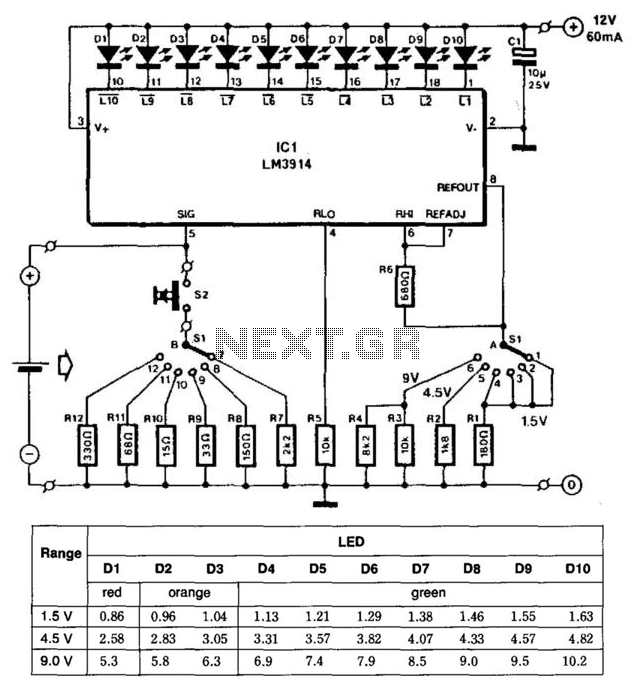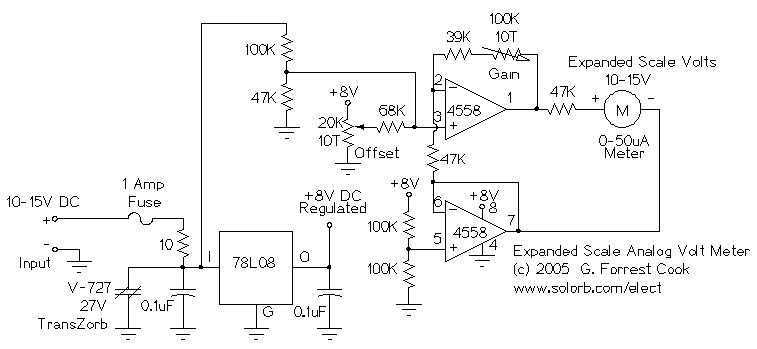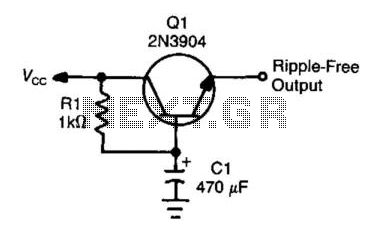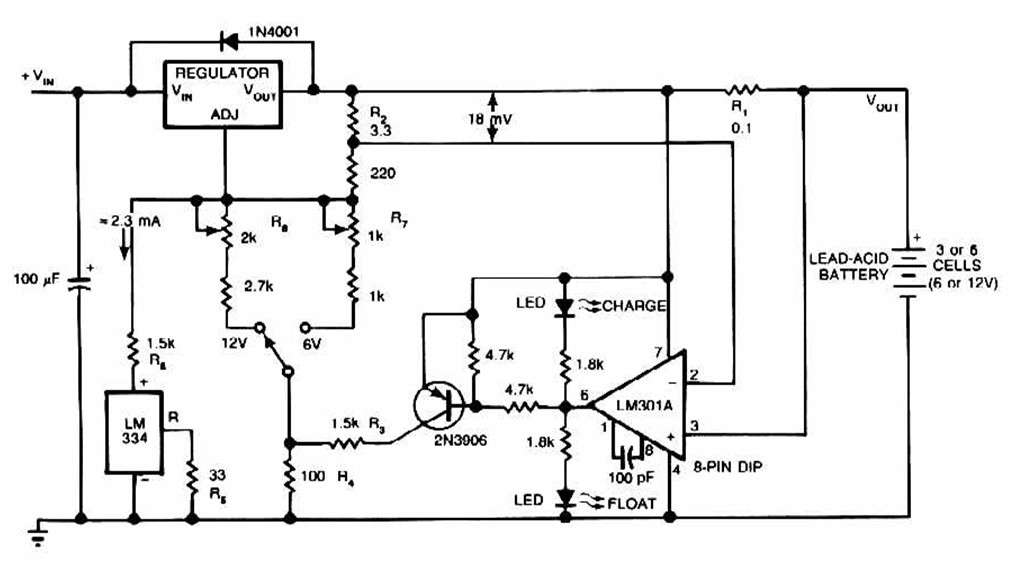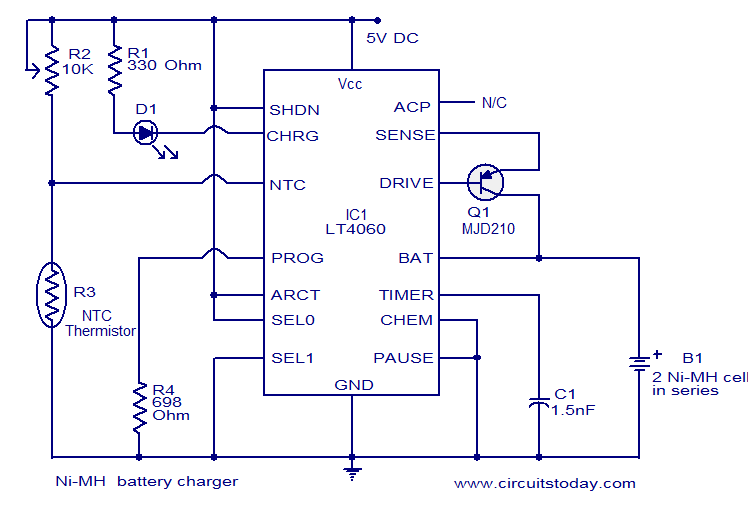
Simple FM transmitter powered by 1.5V battery
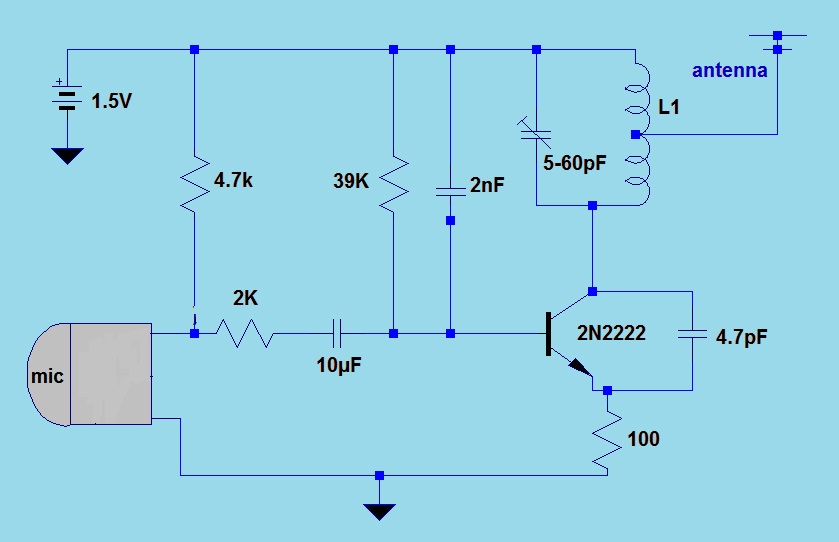
This simple FM (frequency modulation) transmitter is powered only by a 1.5V battery and utilizes a single transistor. The frequency of this transmitter is controlled by the L-C resonance circuit and operates within a range of 80 to 110 MHz. The inductor L1 consists of 8 turns of #22 AWG magnetic wire wound with a diameter of 4-5 cm or the diameter of a pencil. The antenna is a 6-inch copper wire connected at the midpoint of the L1 inductor. Other components are not critical and can be replaced with their closest values. Resistors are of the 1/4 watt type, and capacitors are ceramic, except for the 10 µF electrolytic capacitor. The 5-60 pF capacitor is a trimmer or variable type. Note: Modifying this simple FM transmitter circuit, such as increasing its power capacity, is illegal. Review the FCC limits regarding FM transmitters if planning to build a more powerful version.
This FM transmitter circuit operates on the principle of frequency modulation, which allows for the transmission of audio signals over radio waves. The core component, a single transistor, serves as the active element that amplifies the modulated signal generated by the L-C circuit. The L-C circuit, composed of the inductor L1 and a variable capacitor, defines the operating frequency of the transmitter.
The inductor L1 is constructed with 8 turns of #22 AWG wire, which is a standard gauge for RF applications, ensuring adequate inductance while maintaining manageable resistance. The physical dimensions of the inductor, specifically the 4-5 cm diameter, are crucial as they influence the inductance value and, consequently, the resonance frequency of the circuit.
The antenna, a 6-inch copper wire, is critical for effective transmission, as it radiates the modulated signal into the surrounding environment. The placement of the antenna at the midpoint of the inductor enhances the coupling between the inductor and the antenna, optimizing the efficiency of the transmission.
Resistors used in this circuit are rated at 1/4 watt, suitable for low-power applications, and should be selected based on the desired biasing and gain characteristics of the transistor. Capacitors are primarily ceramic, known for their stability and reliability in RF circuits, with the exception of the electrolytic capacitor, which is used for power supply filtering. The inclusion of a trimmer capacitor allows for fine-tuning of the frequency, facilitating adjustments to meet specific transmission requirements.
It is imperative to adhere to legal regulations concerning FM transmission power levels, as exceeding these limits can lead to legal repercussions. The Federal Communications Commission (FCC) establishes guidelines to ensure that transmissions do not interfere with licensed broadcasts, and any modifications to increase power capacity should be approached with caution and awareness of these regulations.This simple FM (frequency modulation)transmitter is powered only bya 1. 5V batteryand usesonly 1 transistor. The frequency of this transmitteris controlled by the L-C resonance circuit andoperates from 80 to 110 MHz. The inductor L1 is made of 8 turns of #22AWG magnetic wire wound with thediameter of 4-5cmor diameterof a pencil.
The antenna is a 6inc hes copper wireconnected at the middle of L1 inductor. Other parts arenot critical and can be replacedby its closest value. Resistor are1/4 watttypeandcapacitors are ceramic except the 10uF electrolytic capacitor. 5-60pF capacitor is a trimmer type or variable type. Note: Modifying this simple fm transmitter circuit such as increasing itspowercapacity is illegal. Review the fcc limits regarding fm transmitterif you are planningto build a more powerful one. 🔗 External reference
This FM transmitter circuit operates on the principle of frequency modulation, which allows for the transmission of audio signals over radio waves. The core component, a single transistor, serves as the active element that amplifies the modulated signal generated by the L-C circuit. The L-C circuit, composed of the inductor L1 and a variable capacitor, defines the operating frequency of the transmitter.
The inductor L1 is constructed with 8 turns of #22 AWG wire, which is a standard gauge for RF applications, ensuring adequate inductance while maintaining manageable resistance. The physical dimensions of the inductor, specifically the 4-5 cm diameter, are crucial as they influence the inductance value and, consequently, the resonance frequency of the circuit.
The antenna, a 6-inch copper wire, is critical for effective transmission, as it radiates the modulated signal into the surrounding environment. The placement of the antenna at the midpoint of the inductor enhances the coupling between the inductor and the antenna, optimizing the efficiency of the transmission.
Resistors used in this circuit are rated at 1/4 watt, suitable for low-power applications, and should be selected based on the desired biasing and gain characteristics of the transistor. Capacitors are primarily ceramic, known for their stability and reliability in RF circuits, with the exception of the electrolytic capacitor, which is used for power supply filtering. The inclusion of a trimmer capacitor allows for fine-tuning of the frequency, facilitating adjustments to meet specific transmission requirements.
It is imperative to adhere to legal regulations concerning FM transmission power levels, as exceeding these limits can lead to legal repercussions. The Federal Communications Commission (FCC) establishes guidelines to ensure that transmissions do not interfere with licensed broadcasts, and any modifications to increase power capacity should be approached with caution and awareness of these regulations.This simple FM (frequency modulation)transmitter is powered only bya 1. 5V batteryand usesonly 1 transistor. The frequency of this transmitteris controlled by the L-C resonance circuit andoperates from 80 to 110 MHz. The inductor L1 is made of 8 turns of #22AWG magnetic wire wound with thediameter of 4-5cmor diameterof a pencil.
The antenna is a 6inc hes copper wireconnected at the middle of L1 inductor. Other parts arenot critical and can be replacedby its closest value. Resistor are1/4 watttypeandcapacitors are ceramic except the 10uF electrolytic capacitor. 5-60pF capacitor is a trimmer type or variable type. Note: Modifying this simple fm transmitter circuit such as increasing itspowercapacity is illegal. Review the fcc limits regarding fm transmitterif you are planningto build a more powerful one. 🔗 External reference
%2BCircuit%2Bdiagram%2Busing%2BCD4047%2Band%2BIRFZ44%2Bpower%2BMOSFET.png)
